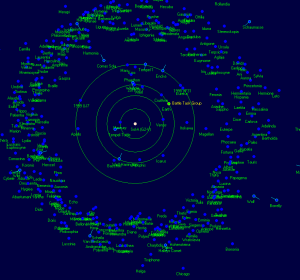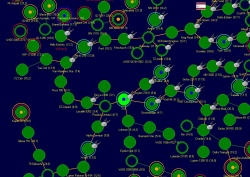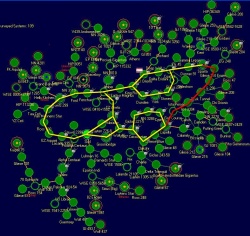Aurora is on version 2.5.0 C#, available at the Aurora Forums.
Contact Erik on the forum for a wiki account.
Difference between revisions of "Galaxy"
| Line 5: | Line 5: | ||
* The '''[[New game]]''' window contains many settings controlling galaxy generation. If '''Real Star Systems''' is selected here, [[Black Holes]] and [[Nebulae]] are not generated. | * The '''[[New game]]''' window contains many settings controlling galaxy generation. If '''Real Star Systems''' is selected here, [[Black Holes]] and [[Nebulae]] are not generated. | ||
| + | ==System generation== | ||
| + | (TBD) | ||
==The galactic wormhole network== | ==The galactic wormhole network== | ||
Revision as of 20:39, 3 April 2016
The galaxy in Aurora consists of many star systems, connected by initially-hidden wormholes (Jump Points). Earth's solar system is meticulously recreated according to known astronomical data, all others are randomly created.
- The galactic map provides access to most high-level information about a system, like jump points connections to other systems, survey progress or presence of fleets.
- The system information screen lists detailed physical data about every system body.
- The New game window contains many settings controlling galaxy generation. If Real Star Systems is selected here, Black Holes and Nebulae are not generated.
System generation
(TBD)
The galactic wormhole network
- See Interstellar travel for information about Jump Points, Jump Gates and gravitational surveying.
Stellar Systems in Aurora are connected by Jump Points. Each system contains at least one connection to another system (otherwise it wold not be accessible because faster-than-light travel is impossible). Usually this leads to chains of systems that branch whenever a system contains three or more jump point connections. Occasionally, though, loops are created. This typically happens through a dormant jump point - a jump point connection that cannot be found from the first of the two systems. Only when discovered and explored from the second system the connection becomes known.
The example map on the left shows a well-established human empire after decades of exploration. Main trade and travel routes between colonies have been highlighted in yellow. The red line in the 'western' part of the galaxy shows a connection that was discovered only in 2093. Previously, these areas were thought to be over a hundred billion km apart. This discovery explained the hitherto mysterious presence of the same hostile alien race in systems separated by vast distances through human-controlled space. Since ships of the same alien race have been spotted in the eastern part of the galaxy also, scientists now believe that another such 'backdoor', connecting 'east' and 'west', is likely to exist.
Note that the position of systems on the galaxy map must be arranged by the player. Discovering a new 'loop' in a galaxy like this can require extensive re-arranging.
Stellar Systems

Stellar system can consist of:
- at least one sun in the center of the system. As in reality, binary, tertiary and quaternary systems (i.e. having two, three or four suns rotate around each other) are quite common in Aurora. All other bodies rotate around one of these suns. The type of sun (size and color) probably affects the variables of system generation, but apart from that, suns play no further role in the game.
- Planets are large rocks. Whether they are habitable for your race and can be colonized depends on many factors, like temperature, gravity, atmospheric pressure or toxic gases. See Terraforming for the details. Abandoned alien ruins are sometimes discovered on planets or moons during orbital survey.
- Dwarf planets are small planets inhabited by small, fierce and industrious humanoids who perform extensive mining operations and need alcohol to get through the day. Trading with them is possible, but highly dangerous.
- Moons are rocks rotating around planets. Some moons possess a thin atmosphere and sometimes enough mass and gravity to be habitable.
- Gas Giants are gaseous planets like Jupiter or Saturn. You cannot found colonies on gas giants: It is difficult to put anything on their surface since they don't have one. Plenty of Sorium is commonly found in their atmosphere and can be extracted and converted to fuel by Sorium Harvesters.
- Super-Jovians are extremely large gas giants. If more than one is present in the system, each is accompanied by a Lagrange Point (LP) in the same stellar orbit. Instant travel between these LPs is possible.
- Asteroids are smaller rocks rotating around a sun. They usually form asteroid belts, although some might be lone outliers. Mining is possible, but their gravity is too low to make them habitable through normal means, although Underground Infrastructure and Orbital Habitat Modules allows inhabited asteroid bases.
- Comets are chunks of ice and dirt that can be mined, although comet orbits can make that problematic (see orbital movement below). They are uninhabitable like asteroids (see above).
Empty star systems containing only a sun but no other bodies are commonly found. They are depicted as systems with a black circle in the center in the Galaxy Map.
The mineral content of a body can be determined through a geological Survey.
System bodies are indestructible.

Weird astronomical phenomena
- Black Holes are remnants of massive stars that have collapsed at the end of their fusion cycle. Due to their extreme gravity, black hole systems pose significant dangers or at least obstacles to spaceship traffic.
- Nebulae are interstellar clouds of dust, hydrogen and other ionized gases. Nebula systems pose challenges for naval combat.
Orbital movement
All bodies rotate around a sun, while moons also rotate around a planet. Comets have highly eccentric elliptical orbits, simulated in the game as a long, straight line on which they move towards the central star, then back to the other end of the line. For example, the comet Brooks in the Sol system has an "orbital line" that is 46 billion km long. You can see comet orbits by switching on "Comet Paths" in the Display tab.
Orbital movement is not constant, but takes place only once every five days to save CPU time.
Orbital motion for Planets/Moons and Asteroids can be switched on or off separately in the Game Settings, saving a little CPU time when playing in very large universes.
Very large systems
Sometimes you'll encounter systems, typically of a multi-star variant, where some of the bodies are orbiting the central star in distances of dozens or even hundreds of billion kilometers, too far for your explorers to reach and examine them and come back. If the outlying bodies include a gas giant, there might be Lagrange Points present that allow instant travel to them. Otherwise you have to postpone exploration until you possess the engine technology to make such long journeys possible.
Non-Player Races
Various alien Races may be encountered when exploring the universe. They colonize habitable worlds, although their environmental tolerances and preferences will vary from those of humans. Just like humans, they also build small outposts for research or equipped with Deep Space Tracking Stations as early-warning posts.

